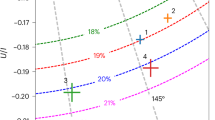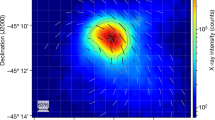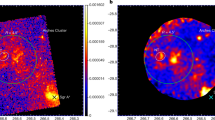Abstract
MEASUREMENTS of the degree of polarization of the nuclear region of NGC 1068 by Kruszewski1 and Visvanathan and Oke2 show that the degree of polarization increases with decreasing diaphragm size, which suggests that the polarization is produced in and close to the nucleus and that the radiation contributed by other parts of the galaxy is unpolarized. In order to find what process or processes are responsible for the optical radiation from the nucleus it is important to determine the intrinsic polarization of the nucleus. To do this we require the dilution factor, D, which is the ratio of the integrated surface brightness of all the radiation from the galaxy within the diaphragm to that of the nucleus. The distribution of surface brightness across the galaxy has been measured with a resolution of 2.6 square seconds by van Houten3; he has corrected the data for the smoothing introduced by finite angular resolution and by atmospheric dispersion to give a resolution of 1 square second. At this resolution the nucleus has a surface brightness S = 12m˙77 (square s)−1; at r = 1 s, S = 16m˙35 (square s)−1. Walker4 places an upper limit of 1.5 s on the nuclear diameter, 2rN, corresponding to a nuclear area of 1.8 square s; we shall assume these values in what follows.
This is a preview of subscription content, access via your institution
Access options
Subscribe to this journal
Receive 51 print issues and online access
$199.00 per year
only $3.90 per issue
Buy this article
- Purchase on Springer Link
- Instant access to full article PDF
Prices may be subject to local taxes which are calculated during checkout
Similar content being viewed by others
References
Kruszewski, A., Astron. J., 73, 852 (1968).
Visvanathan, N., and Oke, J. B., Astrophys. J. Lett., 152, L165 (1968).
Van Houten, C. J., Bull. Astron. Insts. Netherlands, 16, 1 (1961).
Walker, M. F., Astrophys. J., 151, 71 (1968).
Hoyle, F., Nature, 223, 936 (1969).
Rees, M. J., Silk, J. I., Werner, M. W., and Wickramasinghe, N. C., Nature, 223, 788 (1969).
Hoyle, F., and Wickramasinghe, N. C., Nature, 218, 1126 (1968).
Author information
Authors and Affiliations
Rights and permissions
About this article
Cite this article
NANDY, K., WOLSTENCROFT, R. Origin of the Optical Polarization in the Nucleus of NGC 1068. Nature 225, 621–622 (1970). https://doi.org/10.1038/225621a0
Received:
Issue Date:
DOI: https://doi.org/10.1038/225621a0
This article is cited by
-
Is the polarization of NGC1068 evidence for a non-thermal source?
Nature (1983)
-
Polarization of the optical radiation of extragalactic objects
Astrophysics (1975)
-
Aktive galaxien
Die Naturwissenschaften (1975)
Comments
By submitting a comment you agree to abide by our Terms and Community Guidelines. If you find something abusive or that does not comply with our terms or guidelines please flag it as inappropriate.



